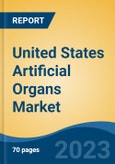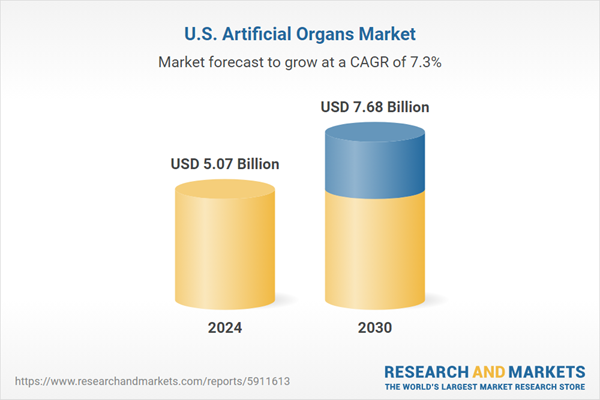Speak directly to the analyst to clarify any post sales queries you may have.
10% Free customizationThis report comes with 10% free customization, enabling you to add data that meets your specific business needs.
Key Market Drivers
Increasing Prevalence of Chronic Diseases
The growing incidence of chronic diseases in the U.S. is a primary factor driving the demand for artificial organs. According to CDC data from May 2024, approximately 38 million Americans have diabetes, with another 98 million classified as pre-diabetic - highlighting a significant portion of the population at risk of severe complications. Chronic illnesses such as kidney failure, heart disease, and liver disorders often require organ replacement. However, the persistent shortage of donor organs and lengthy waiting lists have accelerated interest in artificial alternatives. These bioengineered solutions, including artificial hearts, kidneys, and livers, replicate the functions of natural organs and provide immediate support to patients. With the aging population and continued rise in chronic conditions, the need for artificial organs is expected to grow substantially.Key Market Challenges
High costs of Artificial organs
The elevated cost of artificial organs presents a major barrier to their adoption across the United States. While these devices are lifesaving and technologically advanced, their steep pricing often makes them inaccessible for many, even those with insurance coverage. The cost burden extends beyond the initial implant to include ongoing maintenance, potential replacements, and long-term post-operative care, imposing a significant financial strain on patients and families. These economic hurdles lead many to seek more affordable alternatives or remain on transplant waiting lists. Despite the immense potential of artificial organs, high costs continue to limit their widespread use, and market demand may remain constrained until more cost-effective solutions become available.Key Market Trends
Scarcity of Donor Organs
The limited availability of donor organs in the United States remains a critical challenge for the healthcare system. Thousands of patients are on transplant waiting lists, highlighting the urgent need for alternatives. Artificial organs offer a solution by eliminating reliance on donor availability and enabling production on demand. Advances in medical technology have improved the reliability and functionality of these devices, making them increasingly viable for clinical use. Though challenges such as biocompatibility and durability persist, artificial organs represent a promising avenue to meet transplant demand. The persistent organ shortage is expected to drive further research, development, and investment in this field, positioning artificial organs as a transformative solution in the future of transplantation.Key Market Players
- B. Braun Medical, Inc.
- Abiomed, Inc.
- Baxter International, Inc.
- Jarvik Heart, Inc.
- Medtronic, Inc.
- HeartWare International, Inc.
- SynCardia Systems, LLC
- Boston Scientific Corporation
- Terumo Medical Corporation
- Edwards Lifesciences Corporation
Report Scope:
In this report, the United States Artificial Organs Market has been segmented into the following categories, in addition to the industry trends which have also been detailed below:United States Artificial Organs Market, By Organ Type:
- Artificial Heart
- Artificial Kidney
- Artificial Pancreas
- Artificial Lungs
- Cochlear Implants
- Others
United States Artificial Organs Market, By Technology:
- Electronic Bionics
- Mechanical
United States Artificial Organs Market, By Type of Fixation:
- Wearable
- Implantable
United States Artificial Organs Market, By Material Type:
- Silicon
- Plastic
- Steel
United States Artificial Organs Market, By Region:
- Northeast Region
- Midwest Region
- West Region
- South Region
Competitive Landscape
Company Profiles: Detailed analysis of the major companies present in the United States Artificial Organs Market.Available Customizations:
With the given market data, the publisher offers customizations according to a company's specific needs. The following customization options are available for the report.Company Information
- Detailed analysis and profiling of additional market players (up to five).
This product will be delivered within 1-3 business days.
Table of Contents
Companies Mentioned
- B. Braun Medical, Inc.
- Abiomed, Inc.
- Baxter International, Inc.
- Jarvik Heart, Inc.
- Medtronic, Inc.
- HeartWare International, Inc.
- SynCardia Systems, LLC
- Boston Scientific Corporation
- Terumo Medical Corporation
- Edwards Lifesciences Corporation
Table Information
| Report Attribute | Details |
|---|---|
| No. of Pages | 86 |
| Published | July 2025 |
| Forecast Period | 2024 - 2030 |
| Estimated Market Value ( USD | $ 5.07 Billion |
| Forecasted Market Value ( USD | $ 7.68 Billion |
| Compound Annual Growth Rate | 7.3% |
| Regions Covered | United States |
| No. of Companies Mentioned | 10 |









